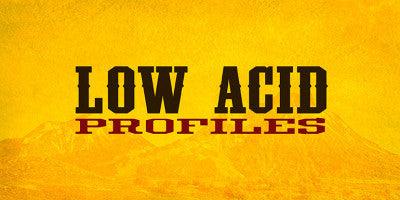
Low Acid Coffee - Profiles
Low Acid Coffee - Profiles
Before you purchase that next bag of light roasted coffee, please keep in mind the chance of it being light roasted and low acid is approximately 1%. That means that if you went to buy a light roast coffee the likelihood that it contains high acid is about 99%. Not very good odds, particularity if high acid coffees bother you.
What is a Low Acid Roast:
We like to refer to Mavericks roasts as slow roasted. Based on the style of roast and the concept behind our roasting profiles and technique. However, since slow roasting produces the lowest levels of acid among any other methods of roasting, it has become synonymous with low acid roasts. We embarked on slow roasting 13 years ago for the simple reason that the coffee tastes more balanced, sweet, and richer than conventional coffee roasts. Coupled with our exclusive use of 100% organic coffee, the cup has a much more natural taste as well.
The fact that Mavericks slow roasting yields low acid coffee has never been the objective. The goal has always been taste and providing a value to our customers. It was serendipitous that slow roasting also produces very low acid coffee.
As coffee roasts, the cellulose structure of the coffee bean is impacted by heat. The observable affect on the properties of coffee bean are noticed when the coffee beans enter a stage of development called the Maillard reaction. The Maillard reaction results in the degradation of amino acids, which is evidenced by the change in color of the coffee. From the green color of raw coffee, to a brief moment when the coffee beans turns white, signaling the beginning of the Maillard reaction, the coffee bean begins to turn yellow as the beans make their way to a tan and later a brown. By the way, this is the same process as applying heat to food products such as browning meat.
Lets take a look at three general stages of roast profiles; light, medium, and dark.
Low Acid Coffee: Light Roast
Since levels of Chlorogenic acid found in coffee affect its acidity. Coffees that are low in Chlorogenic acid are also said to be low acid. Chlorogenic acid levels are reduced as roast temperatures reach over 400F and are maintained at or above that level for a minimum of 10 minutes or more. Many conventional roast profiles are complete within 8 to 14 minutes and including the early stages of the roast when the beans are heating up from room temperature and the including the stages of the roast prior to the Maillaird reaction. While air temperatures within the roaster may exceed 400F for most of the roast, the temperature of coffee beans themselves never reach 400F at anytime during the roast.
Conventional light roast profiles, do not significantly affect Chlorogenic acid. That means that all conventional light roasts are not low acid.
Low Acid Coffee: Medium:
With most medium roasted coffees, the the beans are allowed to develop further and the temperature of the coffee beans are allowed to exceed 400F. This also exposes the coffee bean to air temperatures above 400F for more time. As the beans roast longer, the Maillaird reaction will continue to occur browning the coffee further. With conventional roast profiles, the additional time and temperature can have a mild impact on Cholorogenic acids levels, but not a significant impact.
That means all conventional medium roasts are not low acid.
Low Acid Coffee: Dark Roast
Moving past the medium stage of the roast, air temperatures in the roaster and of the coffee beans are permitted to achieve much higher temperatures. These higher temperatures and extra duration may begin to degrade some of the Cholorogenic acid levels within the coffee bean. However, while there may be a moderate reduction in Chlorogenic acids level, the coffee does typically meet the threshold of low acid.
Keep in mind, even if the roast had a moderating affect on acid levels, coffee drinkers would left drinking solely French and Italian roasts.
Low Acid Coffee: Slow Roasting
At Mavericks, our light roaster coffees are roasted twice as long as the most roasters and our darker roasts, nearly three times as long as most conventional roasters. Each of our roasters, greatly exceed the duration of both the air and bean temperatures benchmarks needed to significantly impact Chlorogenic acid levels. The total reduction in Chlorogenic acid with Mavericks slow roasts are between 70% and 85% .
So whether you prefer a light, medium, or dark roast, Mavericks has a 100% organic and slow roasted coffee that you are sure to enjoy. Whichever Mavericks coffee you chose, it will be low acid.
-Mavericks